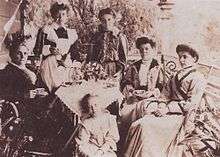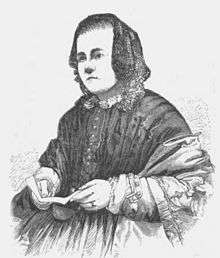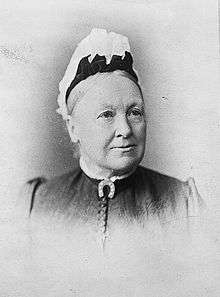Women in Australia
Women in Australia refers to women's demographic and cultural presence in Australia. Historically, a masculine bias has dominated Australian culture.
 Australian women having tea on a verandah in 1910 | |
| Gender Inequality Index[1] | |
|---|---|
| Value | 0.120 (2015) |
| Rank | 24th out of 159 |
| Maternal mortality (per 100,000) | 6 (2015) |
| Women in parliament | 30.5% (2015) |
| Females over 25 with secondary education | 91.4% (2015) |
| Women in labour force | 58.6% (2015) |
| Global Gender Gap Index[2] | |
| Value | 0.730 (2018) |
| Rank | 39th out of 149 |
History
Late 18th-century colonisation
Early colonial administrations were anxious to address the gender imbalance in the population brought about by the importation of large numbers of convict men. The first attempt to redress this balance was in 1777, with the voyage of the Lady Juliana, a chartered ship to carry only female convicts to NSW, but which became notorious on the trip and was nicknamed "the floating brothel"[3] Between 1788 and 1792, around 3546 male to 766 female convicts were landed at Sydney.[4] Women came to play an important role in education and welfare during colonial times. Governor Macquarie's wife, Elizabeth Macquarie took an interest in convict women's welfare.[5] Her contemporary Elizabeth Macarthur was noted for her 'feminine strength' in assisting the establishment of the Australian merino wool industry during her husband John Macarthur's enforced absence from the colony following the Rum Rebellion.[6]
The Catholic Sisters of Charity arrived in 1838 and set about providing pastoral care in a women's prison, visiting hospitals and schools and establishing employment for convict women. They established hospitals in four of the eastern states, beginning with St Vincent's Hospital, Sydney in 1857 as a free hospital for all people, but especially for the poor.[7] Caroline Chisholm (1808–1877) established a migrant women's shelter and worked for women's welfare in the colonies in the 1840s. Her humanitarian efforts later won her fame in England and great influence in achieving support for families in the colony.[8] Sydney's first Catholic bishop, John Bede Polding founded an Australian order of nuns—the Sisters of the Good Samaritan—in 1857 to work in education and social work.[9] The Sisters of St Joseph were founded in South Australia by Saint Mary MacKillop and Fr Julian Tenison Woods in 1867.[10][11] MacKillop travelled throughout Australasia and established schools, convents and charitable institutions. She was canonised by Benedict XVI in 2010, becoming the first Australian to be so honoured by the Catholic Church.[12]

Late 19th-century suffrage

Australia had led the world in bringing women's suffrage rights during the late 19th century. Propertied women in the colony of South Australia were granted the vote in local elections (but not parliamentary elections) in 1861. Henrietta Dugdale formed the first Australian women's suffrage society in Melbourne in 1884. Women became eligible to vote for the Parliament of South Australia in 1895. This was the first legislation in the world permitting women also to stand for election to political office and, in 1897, Catherine Helen Spence became the first female political candidate for political office, unsuccessfully standing for election as a delegate to the Federal Convention on Australian Federation. Western Australia granted voting rights to qualified non-aboriginal women in 1899.[13][14]
1901-1945
Women energetically participated in the war effort, with few signs of defeatism or resistance to government policies.[15] In 1922, the Country Women's Association was formed with the intention to improve the lives of women in rural Australia. It has since expanded to become the largest women's organisation in the country.
Since 1945
.jpg)
In 1974, the Commonwealth Court of Conciliation and Arbitration granted women the full adult wage. However, resistance to women being employed in certain industries remained until well into the 1970s. Because of obstruction from elements of the Unions movement, it would take until 1975 for women to be admitted as drivers on Melbourne's trams, and Sir Reginald Ansett refused to allow women to train as pilots as late as 1979.[16] In 1984, the Sex Discrimination Act became enforced, making sex-based discrimination and sexual harassment illegal.[17] Criminalization of marital rape in Australia began with the state of New South Wales in 1981, followed by all other states from 1985 to 1992.[18]
Analytical writings
Until the 1960s, the Australian national character was typically masculine.[19][20] Only in more recent decades has attention been paid to the role and marginal status of women and minority groups. One of the earliest studies on the role of women in Australian culture was conducted by Miriam Dixson in her 1975 study, The Real Matilda.[19] Dixson concluded that there was deep contempt for women in the Australian ethos and that the only role for women was within the family.[19]
Marilyn Lake argues that the first stage of women's history in the 1970s demonstrated an angry tone, with a revolutionary critique that reflected its close connections with the women's liberation movement. By the late 20th century, women's history was less strident and more thoroughly integrated into social history and labour history. In the 21st century, the emphasis has turned to a broader horizon of "gender relations", which includes such concepts as femininity and masculinity.[21]
Reproductive rights and health
Abortion in Australia is governed by state law rather than on federal law. Abortion was illegal under all circumstances until the 1969 case R v Davidson (also known as the Menhennitt ruling). In this case, Justice Clifford Menhennitt ruled abortion could be considered legal if the physical and/or mental health or the life of the woman was endangered.[22] The ruling was adopted in principle in New South Wales and Queensland in 1971[23] and 1984 respectively.[24] As of 2019, Abortion is legal on demand (up to a certain limit) in all Australian states and territories except for South Australia.[25] [26]It is estimated that a quarter to a third of Australian women will have an abortion in their lifetime,[27] and it has strong popular support.[28]
According to a 2017 study, abortions in Australia have an average cost of $560 after receiving the Medicare rebate, with some women also incurring extra costs from travel, accommodation, GP referrals, lost wages, childcare and medical tests. 34% of women surveyed reported they found payment for abortions difficult or very difficult.[29] The maternal mortality rate in Australia is 5.5 deaths/100,000 live births as of 2015.[30]
Australia, as of 2014, had a total fertility rate (TFR) of 1.8 babies born/woman, reflecting a sub-replacement fertility rate; the replacement rate is 2.1 children born/woman.[31] This TFR has a recorded low of 1.74 in 2001, and a record high of 3.55 in 1961.[32] The TFA has been below the replacement level since 1976.[31]
Women in politics
Despite being given the right to stand for federal election in 1902,[33] women were not present for the first 20 years of Australian politics until the 1921 election of Edith Cowan to the West Australian Legislative Assembly,[34] and were not represented federally until the 1943 federal election when Dorothy Tangney and Enid Lyons were elected to the Senate and the House of Representatives, respectively.[35][36] Lyons would go on to become the first woman to hold a Cabinet position in Robert Menzies' 1949 ministry.[37] Women would not go on to lead a state or territory until Rosemary Follett was elected Chief Minister of the Australian Capital Territory in 1989.[33] Australia's first female Prime Minister, Julia Gillard was appointed in 2010.[38][39]
Since the 1970s, women have received increasing representation in the parliament. Despite examples such as in 2010 females holding every position above them in Sydney, (Clover Moore as Lord Mayor, Kristina Keneally as Premier of New South Wales, Marie Bashir as Governor of New South Wales, Julia Gillard as Prime Minister, Quentin Bryce as Governor-General of Australia and Elizabeth II as Queen of Australia)[33] they still remain a minority in parliament, and as of 2016 only number 32%, an increase of 1% from the previous election.[40]
Other information
- Prostitution in Australia
- Convict women in Australia
- List of Australian women artists
- List of Australian women writers
- List of Australian sportswomen
- Women and government in Australia
- Women in the Australian military
- Women in Christmas Island
- Women in the Cocos (Keeling) Islands
References
- "Table 4: Gender Inequality Index". United Nations Development Programme. Retrieved 13 April 2017.
- "The Global Gender Gap Report 2018" (PDF). World Economic Forum. pp. 10–11.
- "Australia's tragic beginnings: The grotesque story of the Second fleet". www.news.com.au. Retrieved 2019-03-29.
- Fletcher, B. H. "Biography – Arthur Phillip – Australian Dictionary of Biography". Adbonline.anu.edu.au. Retrieved 14 July 2011.
- Barnard, Marjorie. "Biography – Elizabeth Henrietta Macquarie – Australian Dictionary of Biography". Adbonline.anu.edu.au. Retrieved 14 July 2011.
- Conway, Jill. "Biography – Elizabeth Macarthur – Australian Dictionary of Biography". Adbonline.anu.edu.au. Retrieved 14 July 2011.
- "Facility heritage". St Vincent's Hospital, Sydney. Retrieved 2 July 2017.
- Iltis, Judith. "Biography – Caroline Chisholm – Australian Dictionary of Biography". Adbonline.anu.edu.au. Retrieved 14 July 2011.
- "Sisters of The Good Samaritans". Goodsams.org.au. Retrieved 14 July 2011.
- "Brothers in Australia". Cfc.edu.au. Retrieved 14 July 2011.
- "Institute of the Sisters of Mercy of Australia – Who We Are". Mercy.org.au. Retrieved 14 July 2011.
- Thorpe, Osmund. "Biography – Mary Helen MacKillop – Australian Dictionary of Biography". Adbonline.anu.edu.au. Retrieved 14 July 2011.
- "Constitution Acts Amendment Act 1899 (WA)". Museum of Australian Democracy. Retrieved 2017-07-02.
- Constitution Acts Amendment Act 1899 (WA), p.5 et seq at Museum of Australian Democracy
- Adam-Smith, Patsy. Australian Women at War (Thomas Nelson Australia, 1984)
- Bolton, Geoffrey, ed. (1990). 1942-1995: The Middle Way. The Oxford history of Australia. 5 (2nd ed.). p. 229.
- "Face the facts: Gender Equality 2018". Australian Human Rights Commission. Retrieved 22 June 2018.
- Temkin, Jennifer (2002). "Defining and redefining rape". In Temkin, Jennifer (ed.). Rape and the legal process (2nd ed.). Oxford New York: Oxford University Press. p. 86. ISBN 9780198763543.:Citing:"Criminal Law (Rape) (Amendment) Act, 1990, section 5". irishstatutebook.ie. Irish Statute Book. Archived from the original on 29 April 2017. Retrieved 21 December 2017.
- Schaffer, Kay (1988). Women and the Bush: Forces of Desire in the Australian Cultural Tradition. Cambridge University Press. pp. 5–7. ISBN 978-0521368162. Retrieved 23 August 2016.
- Summers, Anne (1975-01-01). Damned Whores and God's Police: The Colonization of Women in Australia. Penguin Books.
- Lake, Marilyn. "Women's And Gender History In Australia" Journal of Women's History (2013) 25#4 pp 190-211
- "Australian Abortion Law". Children by Choice. 18 January 2018. Retrieved 22 June 2018.
- R v Wald (1971) 3 NSW DCR 25. Confirmed in CES v Superclinics (Australia) Pty Ltd [1995] NSWSC 103, (1995) 38 NSWLR 47, Court of Appeal (NSW, Australia).
- R v Bayliss & Cullen (1986) 9 Queensland Lawyer Reports 8.
- Press, Australian Associated (2019-09-26). "Abortion decriminalised in NSW after marathon debate". The Guardian. ISSN 0261-3077. Retrieved 2019-11-25.
- "Adelaidenow.com.au | Subscribe to The Advertiser for exclusive stories". www.adelaidenow.com.au. Retrieved 2019-12-08.
- Willis, Olivia (26 May 2018). "Is abortion legal in Australia? It's complicated". ABC News. Retrieved 22 June 2018.
- de Crespigny, Lachlan J; Wilkinson, Dominic J; Douglas, Thomas; Textor, Mark; Savulescu, Julian (5 July 2010). "Australian attitudes to early and late abortion". The Medical Journal of Australia. 193 (1): 9–12. doi:10.5694/j.1326-5377.2010.tb03732.x. PMID 20618106.
- Shankar, Mridula; Black, Kirsten I; Goldstone, Philip; Hussainy, Safeera; Mazza, Danielle; Petersen, Kerry; Lucke, Jayne; Taft, Angela (22 January 2017). "Access, equity and costs of induced abortion services in Australia: a cross‐sectional study". Australian and New Zealand Journal of Public Health. 41 (3): 309–314. doi:10.1111/1753-6405.12641. PMID 28110510.
- Global, regional, and national levels of maternal mortality, 1990–2015: a systematic analysis for the Global Burden of Disease Study 2015. October 8, 2016. The Lancet. Volume 388. 1775–1812. See table of countries on page 1784 of the PDF.
- "Fertility Rates 2014". Australian Bureau of Statistics. 2014. Retrieved 22 June 2018.
- "Number of births and fertility rate". Australian Institute of Family Studies. Retrieved 22 June 2018.
- "Women in Political Arena". Australian Electoral Commission. 4 December 2007. Retrieved 22 June 2018.
- "Edith Cowan (1861–1932)". Reserve Bank of Australia Banknotes. Retrieved 22 June 2018.
- "Senator Dorothy Tangney 24 September 1943". Parliament of Australia. Retrieved 22 June 2018.
- "Enid Lyons 29 September 1943". Parliament of Australia. Retrieved 22 June 2018.
- Maley, Jacqueline (19 May 2018). "'They only wanted me to pour tea': Enid Lyons and the Liberals' women problem". The Sydney Morning Herald. Retrieved 22 June 2018.
- Kerr, Christian; Franklin, Matthew (24 June 2010). "Julia Gillard 'honoured' to become prime minister as Kevin Rudd stands aside". The Australian. News Limited. Retrieved 22 June 2018.
- Coorey, Phillip; Lester, Tim (24 June 2010). "Gillard becomes Australia's first female prime minister as tearful Rudd stands aside". The Sydney Morning Herald. Archived from the original on 25 June 2010. Retrieved 22 June 2018.
- Hough, Anna (25 August 2016). "The gender composition of the 45th parliament". Parliament of Australia. Retrieved 22 June 2018.
Primary sources
- Daniels, Kay, ed. Australia's women, a documentary history: from a selection of personal letters, diary entries, pamphlets, official records, government and police reports, speeches, and radio talks (2nd ed. U of Queensland Press, 1989) 335pp. The first edition was entitled Uphill all the way : a documentary history of women in Australia (1980).
- Teale, Ruth, ed. Colonial Eve: sources on women in Australia, 1788-1914 (Melbourne : Oxford University Press, 1978)
Further reading
- Alford, Katrina. Production or reproduction?: an economic history of women in Australia, 1788-1850 (Melbourne: Oxford University Press, 1984)
- Cunneen, Chris; Stubbs, Julie (January 2000). "Male violence, male fantasy and the commodification of women through the internet". International Review of Victimology. Sage. 7 (1–3): 5–28. doi:10.1177/026975800000700302.CS1 maint: ref=harv (link) Filipino women in Australia
- Damousi, Joy. Women Come Rally: Socialism, Communism and Gender in Australia 1890–1955 (Melbourne: Oxford University Press, 1994)
- Damousi, Joy, and Marilyn Lake, eds. Gender and War: Australians at War in the Twentieth Century (Melbourne: Cambridge University Press, 1995)
- Daniels, Kay, So Much Hard Work: Women and Prostitution in Australian History (Sydney: Fontana Collins, 1984)
- Dixson, Miriam. The Real Matilda: Woman and Identity in Australia, 1788 to the Present (Penguin Books Australia, 1984)
- Grimshaw, Patricia, Marilyn Lake, Ann McGrath and Marian Quartly. Creating a Nation (Ringwood: Penguin, 1994); a general history of Australia with emphasis on social history and gender
- Grimshaw, Patricia. “The Australian Family: An Historical Interpretation,” in The Family on the Modern World ed. Alisa Burns, Gill Bottomley, and Penny Jools (Sydney: Allen and Unwin, 1983), pp 31–48.
- Hercus, Cheryl. Stepping out of line: Becoming and being feminist (Psychology Press, 2005) excerpt
- Lake, Marilyn. Getting equal: The history of Australian feminism (Sydney: Allen & Unwin, 1999)
- Lake, Marilyn (Winter 2013). "Women's and gender history In Australia". Journal of Women's History. Johns Hopkins University Press. 25 (4): 190–211. doi:10.1353/jowh.2013.0043.CS1 maint: ref=harv (link)
- McMurchy, Megan, Margot Oliver, and Jeni Thornley. For love or money: a pictorial history of women and work in Australia (Penguin Books, 1983)
- Moreton-Robinson, Aileen. Talkin'up to the white woman: Aboriginal women and feminism (Univ. of Queensland Press, 2000)
- Ryan, Edna and Anne Conlon. Gentle Invaders: Australian Women at Work (Melbourne: Penguin, 1975).
- Saunders, Kay, and Raymond Evans, eds. Gender relations in Australia: Domination and negotiation (Harcourt Brace Jovanovich, 1992)
- Sheridan, Susan. Along the Faultlines: Sex, Race and nation in Australian Women’s Writing 1880s–1930s (St Leonard, Australia: Allen and Unwin, 1995).
- Smith, Michelle J., Clare Bradford, et al. From Colonial to Modern: Transnational Girlhood in Canadian, Australian, and New Zealand Literature, 1840-1940 (2018) excerpt


| Wikiquote has quotations related to: Women in Australia |
